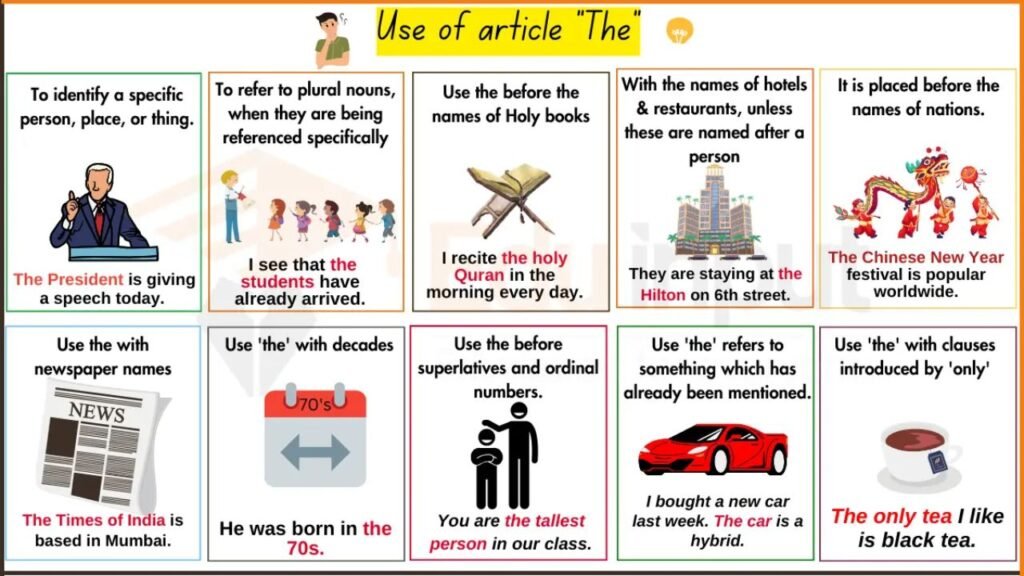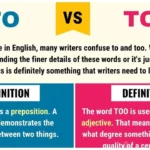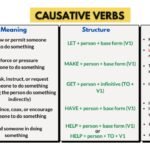Use Of A, An And The: All of you must know that Article is a very important topic for English Grammar. In this post, we have tried to explain the definition, rules, usage and examples of Article very well. We hope that after reading this post, you will get the solution to all your questions related to Article.
According to uses, article is divided into two forms:-
- Indefinite Article (A/An)
- Definite Article (The)
1.Indefinite Article (A/An)
Keep in mind that if the first latter part of a word falls within the range of a consonant sound (K, KH, G…Gy) then it is preceded by the indefinite article ‘A’ whereas if the first latter part of a word falls within the range of a vowel sound (A, Aa, E…Ah:) then it is preceded by the indefinite article ‘An’.
Example: A pen, A dog, An Apple, An umbrella, A University etc
Use Of A, An And The: Definition, Rules And Examples

Uses:
1.> Indefinite Article comes before an indefinite or indefinite singular countable noun.
Example:
- A boy is calling you outside the building.
- I found a wallet on the sidewalk.
- She is reading a fascinating book about space exploration.
- He wants to buy a new phone this weekend.
- There is a cat sleeping on the couch.
2.> Indefinite article comes before kinds of / short of / type of to show an indefinite time.
Example:
- This is a type of software that can help with project management.
- We encountered a kind of problem that we hadn’t anticipated.
- He is dealing with a sort of issue that requires immediate attention.
- She wore a kind of dress that was both elegant and unusual.
- They are studying a type of plant that grows only in tropical climates.
3.> Indefinite article comes to show a unit in the meaning of per.
Example: It is ten rupees per kg. or It is ten rupees a kg.
- The cost of the fruit is $3 a pound.
- We need to charge $10 a hour for the workshop.
- The rental fee is $50 a day for the car.
- The bakery sells bread for $2 a loaf.
- She earns $100 a week from her part-time job.
4.> ‘Numbers of’ gets indefinite article before itself to show a large number of countable noun.
Example:
- A number of students attended the extra class.
- A number of books were donated to the library.
- A number of countries participated in the international conference.
- A number of employees have requested time off this month.
- A number of paintings were displayed at the art gallery.
5.> ‘Amount of’ gets indefinite article before itself to show a large quantity of something.
Example:
- An amount of sugar is needed for the recipe.
- She drank an amount of water after the workout.
- They have a significant amount of data to analyze.
- The company has invested an amount of money in new technology.
- An amount of time was spent preparing for the presentation.
6.> Indefinite article comes before lot of / great deal of / good deal of etc to show a large number or quantity of something.
Example:
- I have a lot of work to finish before the deadline.
- She spent a great deal of time on her research project.
- There is a good deal of interest in the new product line.
- He has a lot of friends in the city.
- We need a great deal of patience to complete this task.
7.> Indefinite article comes before great many / good many to show a large number of countable nouns.
Example:
- A great many people attended the concert last night.
- She has a good many books on her shelf.
- There are a great many opportunities available in this field.
- We have a good many options to choose from for the vacation.
- A great many students were interested in the summer program.
8.> Many + A/An + S.C.N (Singular Countable Noun) + Subject Example:
- Many a student has struggled with this subject.
- Many a book has been written on this topic.
- Many a night was spent studying for the exams.
- Many a teacher has faced challenges in the classroom.
- Many a challenge was encountered during the project.
9.> Indefinite article come before few / little to show a small number or quantity of something.
Example:
- A few friends came over to help with the move.
- I have a little money left after the shopping spree.
- She made a few mistakes in her report.
- There’s a little time remaining before the deadline.
- He has a few ideas for the project that he wants to discuss.
10.> Indefinite article comes before the name of an occupation.
Example:
- She wants to become a doctor.
- He is working as a teacher at the local school.
- My brother is an engineer in a tech company.
- They hired a chef to prepare the meals for the event.
- I met a writer who is famous for her novels.
11.> A/An + Adjective + S.C.N (Singular Countable Noun
Examples:
- She adopted an adorable kitten from the shelter.
- He is looking for a reliable car to buy.
- They need a new solution to the problem.
- I saw a beautiful painting in the gallery.
- We had a challenging discussion about the project.
2. Definite Article (The)

1.> The definite article comes before a certain or definite noun.
Example:
- The Eiffel Tower is in Paris.
- She went to the new restaurant downtown.
- The car parked outside is mine.
- I found the book I was looking for.
- The weather today is quite pleasant.
2.> Definite article comes to make a noun definite.
- The cat is sleeping on the sofa.
- Please hand me the pen on the desk.
- I visited the museum you recommended.
- The children are playing outside.
- Can you close the door?
3.> Truth gets definite article before itself.
Example:
- The truth is often stranger than fiction.
- She finally revealed the truth about her past.
- Understanding the truth can be difficult.
- The truth of the matter is that we need more time.
- He couldn’t handle the truth of the situation.
4.> Kind of / sort of / type of get definite article to show a certain time.
Example:
- The type of music played at the concert was jazz.
- I remember the sort of movie we watched last weekend.
- The kind of food served at the party was Italian.
- We enjoyed the type of book that you recommended.
- The sort of weather we had last summer was unusual.
5.> ‘Number of’ gets definite article to show counting.
Example:
- The number of students in the class has increased.
- We need to calculate the number of participants.
- The number of pages in the book is 300.
- She reviewed the number of applicants for the job.
- The number of cars in the parking lot is growing.
6.> ‘Amount of’ gets definite article before itself to show the quantity of something.
Example:
- The amount of sugar in the recipe is too much.
- We need to measure the amount of water for the experiment.
- The amount of noise in the room is distracting.
- She was surprised by the amount of work required.
- The amount of rainfall this year has been unusual.
7.> A superlative form gets defined before itself.
Example:
- She is the tallest student in the class.
- This is the most interesting book I’ve read.
- He won the fastest runner award.
- It was the coldest winter in years.
- They live in the biggest house on the street.
8.> Definite article before a comparative form also, if we make comparison + selection in (1:2).
Example:
- The taller of the two buildings is more modern.
- The more expensive option is also the better quality.
- The faster runner won the race.
- The brighter color looks more vibrant.
- The older model is less efficient than the new one.
9.> A reciprocal comparison gets the article ‘the’ before itself.
Example:
- The more you read, the smarter you become.
- The less you eat, the more weight you lose.
- The faster you run, the quicker you finish.
- The harder you work, the more you achieve.
- The more you practice, the better you play.
10.> Former / latter gets definite article before itself / themselves.
- The former method was more traditional, while the latter is more modern and efficient. (Referring to two methods previously mentioned)
- The former president’s policies were controversial, but the latter administration has taken a different approach. (Referring to two presidential administrations)
- The former building was demolished, but the latter structure is still under construction. (Referring to two buildings or structures)
- The former proposal was rejected, whereas the latter was accepted by the committee. (Referring to two proposals or suggestions)
- The former speaker gave a passionate speech, whereas the latter was more reserved and formal. (Referring to two speakers or presentations)
FAQ OF A, AN And The
Q1: When do I use “a”?
A1: Use “a” before singular, countable nouns that start with a consonant sound. Example: a cat, a university (sounds like “you”).
Q2: When do I use “an”?
A2: Use “an” before singular, countable nouns that start with a vowel sound. Example: an apple, an hour (sounds like “our”).
Q3: When do I use “the”?
A3: Use “the” to refer to a specific noun that is known to the reader or listener, or when the noun has been mentioned before. Example: the book (previously mentioned), the tallest building (specific reference).
Q4: Can “a” or “an” be used with plural nouns?
A4: No, “a” and “an” are used only with singular, countable nouns. For plural nouns, use no article or “the” if referring to specific items. Example: books (no article), the books (specific).
Q5: When should “the” not be used?
A5: Do not use “the” with general nouns, non-specific items, or names of most countries, cities, and languages. Example: I love chocolate (general), She speaks Spanish (language).
Q6: How do I decide between “a” and “the”?
A6: Use “a” for non-specific, singular items introduced for the first time. Use “the” for specific items that are known or have been previously mentioned. Example: I saw a movie (any movie), The movie was great (the specific one mentioned).
Q7: Are there exceptions to the rules?
A7: Yes, some nouns and phrases have specific rules or exceptions, such as “the” used with unique objects (e.g., the sun, the internet) and some idiomatic expressions (e.g., in the morning).
Read Also:
- Uncountable Noun: Definition, Rules, Structure, And Examples
- Material Noun: Definition, Examples, Rules And Structure
- What is Collective Noun? Rules, Examples And Definition
- Use Of At, In And On: Rules, Examples And Sentences For Job
- What Is Countable Noun? Rules, Structure, Formula And Examples With Full Information






